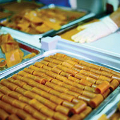The Philippine mangoes‘ unequaled sweetness and juiciness make them one of the country’s top food exports. This is why the Department of Science and Technology’s Industrial Technology Development Institute is constantly discovering other possible mango byproducts to offer to the domestic and international markets. The agency has actually stumbled into another way of preserving mango: Leathering, or turning it into candy.

Mango leathers, more commonly known as dried mango (in strips or rolls) are considered high-value products and they are within reach of the A,B and C markets. The processing may be simple, but the yield may not be ideal for a backyard operation. Five kilos of mangoes usually produce less than a kilo of mango leather. Despite the high capital investment and longer payback period, there may be a huge potential in the product, especially since the healthy trend is gaining momentum.
YOU’LL NEED:
– Table-ripe carabao mangoes
– white sugar
– chlorine
– knife
– stainless steel trays
– stainless steel mixing bowls
– stainless steel spoons
– 2 weighing scales (use one for the raw fruits and the other one for the processed product to avoid contamination)
– refractometer–this device is used to measure the fruit’s sweetness. It can be bought from laboratory equipment suppliers for about P7,000.
– blender
– dryer (optional)
– stove
– oriental polyprophyline laminated with polyethylene (OPPE) metalized plastic for packaging
Procedure:
Step 1: Choose quality mangoes: check if they are the right ripeness and are free of fungus or any insect infestation. Wash the mangoes with tap water to remove dirt, then sanitize by soaking in chlorinated water for 10 minutes.
Step 2: Sanitize the knife, trays, spoons and weighing scales using chlorinated water, too. Clean the area where the mangoes will be processed. It is ideal to work on a table with a formica top.
Step 3: Slice the mango and scoop out the meat, then puree in a blender and transfer to a stainless steel mixing bowl.
Step 4: Measure the puree’s sweetness by dropping a bit of it on the refractometer. The puree should be 20 Brix; add refined sugar if it’s less than the desired sweetness.
To determine how much sugar is needed, subtract the actual reading from the desired reading (20 Brix). Then divide it by 80 (the difference between 100, the measure of pure sugar sweetness, and 20, the desired sweetness). Multiply the quotient with the puree’s weight. If the puree weighs five kilos and its actual sweetness is 17 Brix, the calculation would be 20 minus 17 = 3. Divide that by 80 and multiply by 5 = 0.1875 kilos or 187.5 grams.
Step 5: Pasteurize the mixture. Heat the puree over the stove at 80oCelsius for 10 minutes using a double boiler. This step kills microorganisms and enzymes.
Step 6: Pour the puree onto the stainless steel trays. Spread evenly by tapping the tray, making a layer about one millimeter thick. A five-kilo mango puree would use up to two and a half regular-sized stainless steel trays.
Step 7: If you opt to sundry the mango puree, dry it for three to four days, taking care that no insect would contaminate the trays. The rolls would turn brownish instead of yellowish when dried under the sun.
If using a machine to dry your mangoes, a fabricated dryer can process up to 250 kilos of mango leather, but it costs P300,000. With this machine, the puree can be dried at 50o Celsius for an hour, then at 60o to 65o in the next seven to nine hours. After drying, let the mango leather rest for 18 hours. This process allows the mango leather to sweat and balance its moisture content.
Step 8: Take the mango leather from the tray, cut them into inch-thick strips and then roll them on confectioner’s or plain white sugar. Place them inside plastic packets. Oriental polyprophyline laminated with polyethylene (OPPE) metalized plastic is an ideal packaging material as it seals in freshness and helps preserve the product by up to eight months.
Where to train:
Department of Science and Technology’s Industrial Technology Development Institute (DOST-ITDI)
Telephones: (02) 837-6156, (02) 837-2071 local 2187
Source: By Millet M. Enriquez- entrepreneur.com.ph




Interesting blogs, please drop by my blogs when you get a chance. Business and Financial talks